You are using an out of date browser. It may not display this or other websites correctly.
You should upgrade or use an alternative browser.
You should upgrade or use an alternative browser.
Cumulative PM-based History Quiz II
- Thread starter Knight-Dragon
- Start date
- Status
- Not open for further replies.
Adler17
Prussian Feldmarschall
I am lucky that our light bringer had the quiz before. However I have already some ideas. But since I have exam class works next week be a bit patient with the new quiz.
Thanks in advance.
Adler
Thanks in advance.
Adler
Ciceronian
Latin Scholar
So luceafarul has now submitted a complete version of question 3, predictably scoring the full 10 points, bringing his score up to an incredible 54 points! I also completely forgot about Rambuchan's submission, who had submitted just in time, but I forgot his PM. He scored 27.5 points, that should make him stow his griping for a while!  So the final leaderboard is:
So the final leaderboard is:
Luceafarul...54
Adler17.......41.5
Sydhe.........39
Hornblower.37.5
Aion...........36
Jameson.....35.5
El_Tigre......35
Taliesin.......32.5
Rambuchan..27.5
Plotinus......21.5
Till.............12
As to indentifying the persons, noncon and trooper were right, it's Schweitzer and Kafka on there. Taliesin was getting into the right kind of area with Ptolemy, especially as the two depicted ancients' names both start with P. The fifth isn't Heisenberg, I think luceafarul will be needed to identify him!
EDIT: Second part of answers are now here:
This is taken from the famous "Song of Roland", the oldest major piece of French literature, which already in the medieval period was translated into many other languages, and later on inspired other literary works, such as Ariosto's "Orlando Furioso". It was first written in Old French in the 11th century, describing events in the late 8th century in northern Spain / the Pyrenees. Charlemagne and his Franks are returning from a campaign in Spain, when the rearguard under the hero Roland is ambushed by the treacherous Saracens under Marsilion, who was informed by the traitor Ganelon (spelt Guenelun in this passage), who bears a personal grudge against Roland. The first word of the passage deleted by me was "Roland", which would have been quite give-away, but I still wanted to choose this passage as it contained names of other main characters (Ganelon and Charles) and the name of Roland's horn, Olifant. Roland hesitates to sound his horn, which will alert Charles and the main army, and only does so when it is already to late, and Charles returns to find the dead Roland, who has slain many of Marsilion's most important men. The story continues to describe Charles' revenge on the Saracens, defeating their army and converting the inhabitants of Zaragoza, and concludes after Ganelon has been convicted of treason in a trial and executed. The epic echoes many of the themes of the Crusades, i.e. the battle between Christianity and the unbelieving Muslims and the Christians' duty to convert the heathens.
a) True. After conquering Babylon he released the Israelites from captivity, which merited him this title.
b) True. Idi Amin was very, very mad...
c) False. Everyone got this one. The Pope visited Agca in prison and forgave him.
d) False. Magellan set out on an expedition to circumnavigate the world in 1519. However he was killed when by natives when he reached the Phillipines, and so Juan Sebestián Elcano took over as captain and reached Spain again in 1521. However, he was not the first man to circumnavigate the world: Enrique of Malacca, also known as Henry the Black was an Indonesian slave who had been captured and brought to Spain before the expedition. He was then taken along by Magellan as an interpreter for when they reached the region. When they did indeed reach it, Enrique found that he could understand the natives and realised he had crossed the globe, having first been taken westwards to Spain around Africa, and then having rounded South America to return to his home. Thus he technically became the first man to circumnavigate the world. (Perhaps the luckiest answerer here was one who said something like "False, it wasn't Elcano but Magellan!", but he never actually circumnavigated the world.)
e) False. The previous one was tricky, but this was a real red herring, a complete and utter trap. I think more than half answered true. In fact this is a coin of the very civilised looking Greco-Bactrian ruler Antimachus I who ruled from about 185 to 170 BC, so about two millenia before the supposed Dutch businessman in question! I don't know if any wealthy Renaissance era businessmen ever minted coins depicting themselves, but many of you certainly thought so! Here's a link to some more coins showing Antimachus I.
In 393 BC, the Gauls under their leader Brennus beat the Romans at the battle of the Allia, not far from the gates of Rome. They then entered the defenceless city, with many Romans withdrawing to the castle on the Capitol. The rest of the story is well-known, the geese raising the alarm, "Vae victis!" and so on. Anyway, the 17th century artist depicts the army of Brennus crossing the Tiber to enter Rome. However, he wasn't aware of the fact that the Castel Sant'Angelo was only built as a mausoleum by the emperor Hadrian between 135 and 139 AD, and converted into a castle later, and so he added it to his engraving. Congrats to Aion for being the only one to solve this completely, although others got it partially right.
As to the engraver, nobody identified him. This was hard, I admit, but I was hoping some people would simply guess, for the Swiss engraver, Mätthaus Merian the Elder was perhaps the most notable engraver of his time.
I was reading about Brennus' invasion of Rome in a German history magazine, and they printed Merian's engraving of the scene, and it took my interest. I thought I could use it for a history quiz and scanned it in, since I couldn't find it online.
The Mahabharata, sometimes just called Bharata, is one of the two major ancient Sanskrit epics of India, the other being the Ramayana. It is the longest literary epic poem in the world. Many people guessed The Epic of Gilgamesh, but that is in fact much shorter, containing only about 3 000 lines compared to the Mahabharata's about 100 000.
The pictures all have a connection to Friedrich (Frederick) II of Prussia, also known as Friedrich der Große (Frederick the Great), who lived from 1712 to 1786 and ruled from 1740 until his death. He is the archtypal enlightend absolutist ruler, the "philsopher-ruler" as opposed to the earlier despotic monarch. He advocated freedom of religion and abolished the use of torture. Well known for his patronage of the arts, he attracted many famous artists, composers and philosophers of the day to his court. JS Bach visited the king in 1747, and was challegened by him to improvise a fugue on the theme shown in the first picture, known as the "Thema Regium" or Theme of the King, which he managed to accomplish with considerable skill. Bach later published "The Musical Offering" based on the theme of the fugue. Picture 2 depicts the famous philosopher Voltaire who visited Frederick from 1750 to 1753, after having corresponded with him via letters for a while, but at the end of his stay Voltaire departed in anger after an argument with the king. But Frederick had already been interested in philosophy for a long time before Voltaire visited him. In 1740 he had published his "Antimachiavel", which is a rebuttal of Niccoló Machiavelli's (picture 3) "Il Principe". The fourth picture shows Frederick's residence at Potsdam, Sanssouci, meaning "no worries" in French, which was built by him, and is still considered one of the most important works of North German rococo. The last picture finally is a reference to Frederick's introduction of the potato to Prussia (he also introduced the turnip), leading to the modernisation of the Prussian agriculture.

Aulus Cornelius Celsus (about 25 BC - 50 AD) was a Roman encylcopedist and possibly also physician. His only extant work, the "De Medicina" is only part of an encyclopedia he apparently compiled. It was rediscovered in 1478, and his eloquent style ensured his subsequent popularity during the Renaissance. The person in the picture is Theophrastus von Hohenheim (full name Theophrastus Philippus Aureolus Bombastus von Hohenheim), who lived from 1493 to 1541. He became a famous alchemist, astrologer and physician, and held many new controversial views, for instance that wounds would heal by themselves if prevented from becoming infected, as opposed to cauterising them by pouring boiling oil onto them. He was however also known as being very arrogant, which is not surprising, considering he changed his name to Paracelsus, literally "surpassing Celsus".
All three composers were born in 1685.
Composer 1: Johann Sebastian Bach
Composer 2: Georg Friedrich Händel (anglicised to George Frederick Handel) - The piece of music in question was his "Water Music", which premiered in 1717 after King George I had requested a concert to be performed on the Thames. So Händel specially composed the Water Music for performance by an orchestra on the barges.
Composer 3: Domenico Scarlatti, who was born in Naples.
As I thought, Scarlatti proved to be the most difficult to identify, although a few got him.
 So the final leaderboard is:
So the final leaderboard is:Luceafarul...54
Adler17.......41.5
Sydhe.........39
Hornblower.37.5
Aion...........36
Jameson.....35.5
El_Tigre......35
Taliesin.......32.5
Rambuchan..27.5
Plotinus......21.5
Till.............12
As to indentifying the persons, noncon and trooper were right, it's Schweitzer and Kafka on there. Taliesin was getting into the right kind of area with Ptolemy, especially as the two depicted ancients' names both start with P. The fifth isn't Heisenberg, I think luceafarul will be needed to identify him!
EDIT: Second part of answers are now here:
7. Which famous literary work is the following extract taken from (3 points):
[…] hath set the olifant to his mouth,
He grasps it well, and with great virtue sounds.
High are those peaks, afar it rings and loud,
Thirty great leagues they hear its echoes mount.
So Charles heard, and all his comrades round;
Then said that King: "Battle they do, our counts!"
And Guenelun answered, contrarious:
"That were a lie, in any other mouth."
In which language (1 point) and century (1 point) was it originally composed? In which century (1 point) and where (1 point) do most of the events it describes (including this one) take place?
This is taken from the famous "Song of Roland", the oldest major piece of French literature, which already in the medieval period was translated into many other languages, and later on inspired other literary works, such as Ariosto's "Orlando Furioso". It was first written in Old French in the 11th century, describing events in the late 8th century in northern Spain / the Pyrenees. Charlemagne and his Franks are returning from a campaign in Spain, when the rearguard under the hero Roland is ambushed by the treacherous Saracens under Marsilion, who was informed by the traitor Ganelon (spelt Guenelun in this passage), who bears a personal grudge against Roland. The first word of the passage deleted by me was "Roland", which would have been quite give-away, but I still wanted to choose this passage as it contained names of other main characters (Ganelon and Charles) and the name of Roland's horn, Olifant. Roland hesitates to sound his horn, which will alert Charles and the main army, and only does so when it is already to late, and Charles returns to find the dead Roland, who has slain many of Marsilion's most important men. The story continues to describe Charles' revenge on the Saracens, defeating their army and converting the inhabitants of Zaragoza, and concludes after Ganelon has been convicted of treason in a trial and executed. The epic echoes many of the themes of the Crusades, i.e. the battle between Christianity and the unbelieving Muslims and the Christians' duty to convert the heathens.
8. A very old game: true or false. It hasn’t cropped up in history quizzes for a while though, so let’s have a go. Below I will present five statements. Simply say if each one is true or false. 5 points if you get all right, 3 points if you four right, and 1.5 points if you get three correct.
a) Cyrus the Great is called a “messiah” in the Bible.
b) One of the official titles Ugandan dictator Idi Amin granted himself was “King of Scotland”.
c) Pope John Paul II never forgave his would-be assasin Ali Agca.
d) This coin of himself was issued by an extremely wealthy 17th century Dutch businessman.
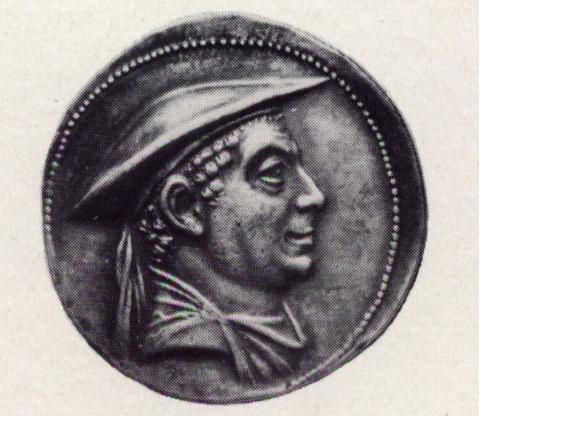
e) Juan Sebastián Elcano was the first man to circumnavigate the globe.
a) True. After conquering Babylon he released the Israelites from captivity, which merited him this title.
b) True. Idi Amin was very, very mad...
c) False. Everyone got this one. The Pope visited Agca in prison and forgave him.
d) False. Magellan set out on an expedition to circumnavigate the world in 1519. However he was killed when by natives when he reached the Phillipines, and so Juan Sebestián Elcano took over as captain and reached Spain again in 1521. However, he was not the first man to circumnavigate the world: Enrique of Malacca, also known as Henry the Black was an Indonesian slave who had been captured and brought to Spain before the expedition. He was then taken along by Magellan as an interpreter for when they reached the region. When they did indeed reach it, Enrique found that he could understand the natives and realised he had crossed the globe, having first been taken westwards to Spain around Africa, and then having rounded South America to return to his home. Thus he technically became the first man to circumnavigate the world. (Perhaps the luckiest answerer here was one who said something like "False, it wasn't Elcano but Magellan!", but he never actually circumnavigated the world.)
e) False. The previous one was tricky, but this was a real red herring, a complete and utter trap. I think more than half answered true. In fact this is a coin of the very civilised looking Greco-Bactrian ruler Antimachus I who ruled from about 185 to 170 BC, so about two millenia before the supposed Dutch businessman in question! I don't know if any wealthy Renaissance era businessmen ever minted coins depicting themselves, but many of you certainly thought so! Here's a link to some more coins showing Antimachus I.
9. This copperplate engraving is from the 17th century, and it depicts an event which took place long before. As is usual in the past, knowledge about previous more ancient history was often very limited. One obvious deficit is the attire of the soldiers, which looks fairly contemporary to the artist’s time, and not to the time of the event.
We can see an army crossing a river to enter a city. The army has just won a famous battle not far from the city itself, which would go down as one of the most ignominious defeats in the history of the defeated nation. What was the name of that battle (3 points)? Who is the leader of the army (1 point)? What is the name of the city being entered (1 point)? On the engraving we see a building which was built around 500 years after the event. What is its name (2 points)?
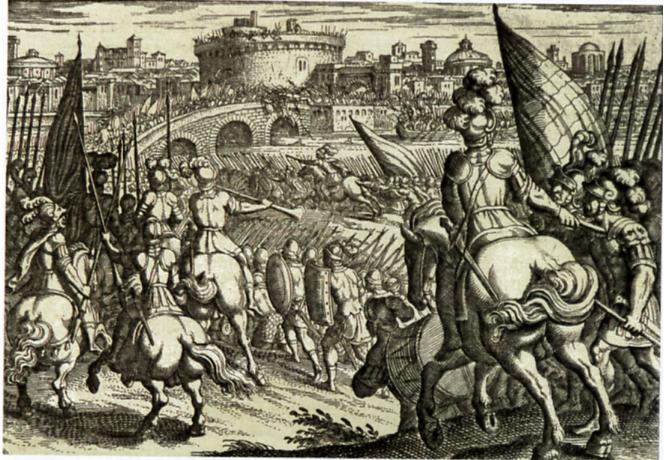
Bonus: The engraver himself is depicted below. What is his name (2 points)?
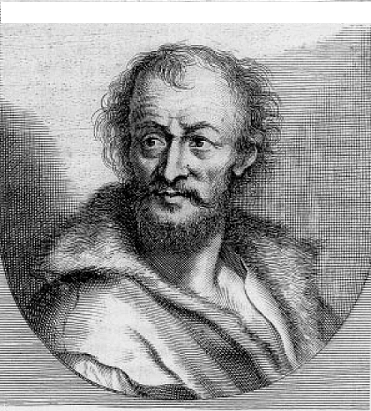
In 393 BC, the Gauls under their leader Brennus beat the Romans at the battle of the Allia, not far from the gates of Rome. They then entered the defenceless city, with many Romans withdrawing to the castle on the Capitol. The rest of the story is well-known, the geese raising the alarm, "Vae victis!" and so on. Anyway, the 17th century artist depicts the army of Brennus crossing the Tiber to enter Rome. However, he wasn't aware of the fact that the Castel Sant'Angelo was only built as a mausoleum by the emperor Hadrian between 135 and 139 AD, and converted into a castle later, and so he added it to his engraving. Congrats to Aion for being the only one to solve this completely, although others got it partially right.
As to the engraver, nobody identified him. This was hard, I admit, but I was hoping some people would simply guess, for the Swiss engraver, Mätthaus Merian the Elder was perhaps the most notable engraver of his time.
I was reading about Brennus' invasion of Rome in a German history magazine, and they printed Merian's engraving of the scene, and it took my interest. I thought I could use it for a history quiz and scanned it in, since I couldn't find it online.
10. Which surviving 2nd millenium BC epic poem is around four times longer than the Bible? (4 points)
The Mahabharata, sometimes just called Bharata, is one of the two major ancient Sanskrit epics of India, the other being the Ramayana. It is the longest literary epic poem in the world. Many people guessed The Epic of Gilgamesh, but that is in fact much shorter, containing only about 3 000 lines compared to the Mahabharata's about 100 000.
11. Which famous person is connected to the following pictures (4 points)? (Should be solvable!) What is the name of the musical theme in picture one (1 point) and what is the story associated with it (2 points)? Identify the person in the second and third picture (2 x 1 point) and the place in the fourth picture (1 point).
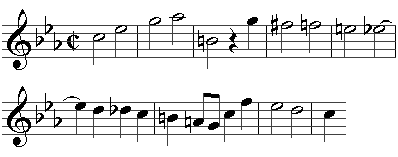
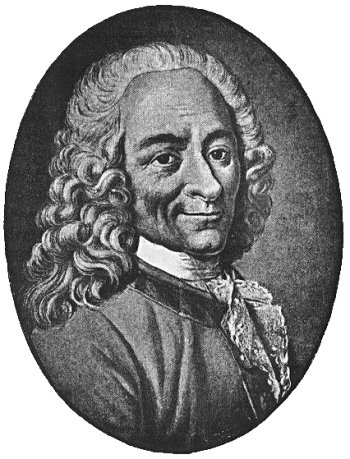

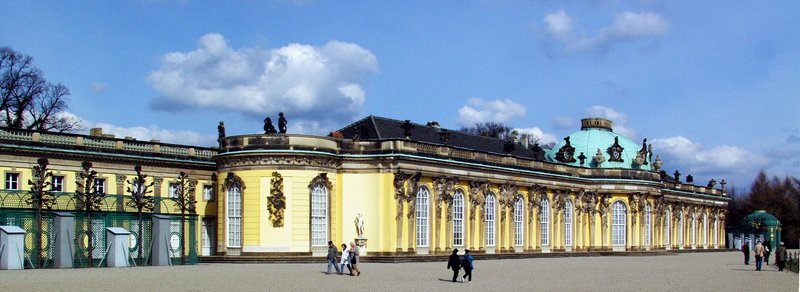

The pictures all have a connection to Friedrich (Frederick) II of Prussia, also known as Friedrich der Große (Frederick the Great), who lived from 1712 to 1786 and ruled from 1740 until his death. He is the archtypal enlightend absolutist ruler, the "philsopher-ruler" as opposed to the earlier despotic monarch. He advocated freedom of religion and abolished the use of torture. Well known for his patronage of the arts, he attracted many famous artists, composers and philosophers of the day to his court. JS Bach visited the king in 1747, and was challegened by him to improvise a fugue on the theme shown in the first picture, known as the "Thema Regium" or Theme of the King, which he managed to accomplish with considerable skill. Bach later published "The Musical Offering" based on the theme of the fugue. Picture 2 depicts the famous philosopher Voltaire who visited Frederick from 1750 to 1753, after having corresponded with him via letters for a while, but at the end of his stay Voltaire departed in anger after an argument with the king. But Frederick had already been interested in philosophy for a long time before Voltaire visited him. In 1740 he had published his "Antimachiavel", which is a rebuttal of Niccoló Machiavelli's (picture 3) "Il Principe". The fourth picture shows Frederick's residence at Potsdam, Sanssouci, meaning "no worries" in French, which was built by him, and is still considered one of the most important works of North German rococo. The last picture finally is a reference to Frederick's introduction of the potato to Prussia (he also introduced the turnip), leading to the modernisation of the Prussian agriculture.

12. In the Middle Ages I became known as the “Cicero Medicinorum”, the Cicero of physicians, thanks to my elegant style. This man thought he surpassed me and changed his name accordingly:

What was my name? (3 points) What was the original name of the depicted man before he changed it? (2 points)
Aulus Cornelius Celsus (about 25 BC - 50 AD) was a Roman encylcopedist and possibly also physician. His only extant work, the "De Medicina" is only part of an encyclopedia he apparently compiled. It was rediscovered in 1478, and his eloquent style ensured his subsequent popularity during the Renaissance. The person in the picture is Theophrastus von Hohenheim (full name Theophrastus Philippus Aureolus Bombastus von Hohenheim), who lived from 1493 to 1541. He became a famous alchemist, astrologer and physician, and held many new controversial views, for instance that wounds would heal by themselves if prevented from becoming infected, as opposed to cauterising them by pouring boiling oil onto them. He was however also known as being very arrogant, which is not surprising, considering he changed his name to Paracelsus, literally "surpassing Celsus".
13. Name the following three composers (3 x 1 point) and the year in question (1 point) as well as the city mentioned by Composer 3 (1 point):
All: The three of us are famous composers and were born in the same year.
Composer 1: A famous statement of mine: “The aim and final reason of all music should be nothing else but the Glory of God and the refreshment of the spirit.” I admired Composer 2, but we never met, even though we almost did once, having been only 30 km apart.
Composer 2: One of my most famoust famous pieces premiered on a barge.
Composer 3: I was born in the same ancient city as the philosopher Giambattista Vico was born and died. My father was a similarly acclaimed composer, although today we are both not as famous as Composers 1 and 2. The story goes that at a trial of skill with Composer 2 I was adjudged superior to him on the harpsichord, although inferior on the organ. Later in life, I was known to cross myself in veneration, when speaking of Composer 2’s skill. Not many of my works were published in my lifetime, but amongst them is a collection of 30 exercises, perhaps my most well-known work.
All three composers were born in 1685.
Composer 1: Johann Sebastian Bach
Composer 2: Georg Friedrich Händel (anglicised to George Frederick Handel) - The piece of music in question was his "Water Music", which premiered in 1717 after King George I had requested a concert to be performed on the Thames. So Händel specially composed the Water Music for performance by an orchestra on the barges.
Composer 3: Domenico Scarlatti, who was born in Naples.
As I thought, Scarlatti proved to be the most difficult to identify, although a few got him.
thetrooper
Misanthrope
- Joined
- May 24, 2004
- Messages
- 9,135
Ciceronian said:Taliesin was getting into the right kind of area with Ptolemy, especially as the two depicted ancients' names both start with P. The fifth isn't Heisenberg, I think luceafarul will be needed to identify him!
Plutarch perhaps?
As for the task of weaving these people together...

Adler17
Prussian Feldmarschall
Okay, here are my questions:
1. Who am I?



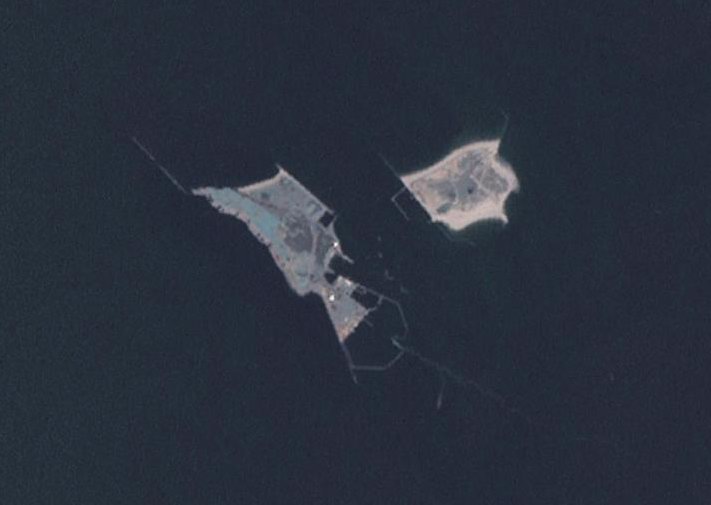


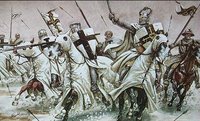
Who am I (25 pts.). What relation do have the pictures for me (5 pts. each)? Who were the opponent of picture #5 (5 pts.)? The ship has a certain name. Which one (10 pts)? Who was her commander (10 pts)? Who was my main companion (10 pts.)? Who was the commander of picture 7 (10 pts.)? Tell the legend concerning my death (15 pts). At last: Tell the motto of my "society" (5 pts.).
115 pts in total!
2. What fleet got the name Mad Dog Fleet (5 pts) and why (5 pts.)? Due to that incident something had to happen which never happened before. What (10 pts.)
20 pts.
3. Who were called the Dutch of the Mountains (10 pts.)? Who called them and what is this called in their language (10 pts each). What was the reason for that designation (10 pts.)? And at last who was the person to be called so (15 pts.). If he returned to that country he would have seen a dramatic change. Which one (10 pts.)? Who caused that change (10 pts.)?
65 pts.
4. Who were we? Name us so: A I. 1. a)
A. Moses Mendelsson
B. Wilhelm Frankl
C. Walter Rathenau
D. Gerson v. Bleichröder
E. Albert Mosse
I. I was a great philosopher of my time.
II. Due to my help and especially money a great man could act. (5 pts. bonus: who?)
III. I was introducing a new economy system in times of a great crise.
IV. I was a fighter ace and credited with the first victory over an opponent at night.
V. I was the first Jewish judge on a German Oberlandesgericht (Courts of appeals (. Bonus (5 pts.): Which one?)) and one of the leading commentator of the German HGB (Commerce Law).
1. 1846- 1925
2. 1822- 1893
3. 1729- 1786
4. 1893- 1917
5. 1867- 1922
a)

b)

c)
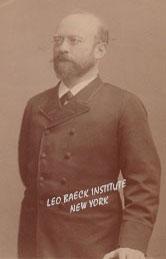
d)

e)

15 points for each solved row. Sorry, but the row has to be fully solved!
85 pts.
5. Who was the legendary runner after the battle of Marathon (15 pts.)? When he started that run he was already exhausted. Why (20 pts.)? Also what error was made by the destination of the month of the battle (20 pts.)? At last who made that error (10 pts)?
65 pts.
6. What was in Naval Combat traditions a Gentlemen`s fight (15 pts)? And when did the last one take place and between whom (15 pts.)?
30 pts.
7. What is the name of the Aboriginal spiritual dimension (10 pts)? Name also the 7 tribes/ people of the Aboriginals (5 pts. each).
45 pts.
8. The Aborigines are not only another designation for the Aboriginals but also for a (mythical) people in another part of the world. Where (15 pts.)? And who is said to be descendent from these people (15 pts)?
30 pts.
Clarification: With Aboriginal people I meant the people designations given by the Aborigines for themselves: So one tribe family might call themselves Smith while another calls themselves Jones. So Smith and Jones are the answers.
9. The English wanted to pay François Charles Achard 100.000 Thaler. Why (15 pts.)? Despite his French name he was no French, but of French origin. Where did he live (10 pts)?
25 pts.
10. Who was the girl friend of Hernándo Cortéz (10 pts.)? What was her name in Spanish (15 pts.)? This Spanish name had also an equivalent in Nahuatl. Which one (15 pts.)? A tip: from this her now common name is derivated. It has also a suffix. Which one and what does it mean (10 pts.)?
50 pts.
11. What was the first western movie (10 pts.)? From which yerar (10 pts.)?
20 pts.
12. We all know the count down especially in Space travels. However it is also based in a sci- fi movie. Which one (20 pts.)? Who was the director (15 pts.)? And at last what famous sci- fi movie did he make also (15 pts)?
50 pts.
600 pts. in total.
Since I do not have much time I had to build up a quiz from certain ideas to questions I wanted to use in several quizzes. That´s why this quiz is very European based, too much I originally wanted. I am sorry for that but I did not want to let you wait for long. Also it is a bit more difficulty than I wanted. And since I have not much time now, the end of this quiz will be Tuesday February 28th 2006.
Have fun and good luck!
Adler
1. Who am I?







Who am I (25 pts.). What relation do have the pictures for me (5 pts. each)? Who were the opponent of picture #5 (5 pts.)? The ship has a certain name. Which one (10 pts)? Who was her commander (10 pts)? Who was my main companion (10 pts.)? Who was the commander of picture 7 (10 pts.)? Tell the legend concerning my death (15 pts). At last: Tell the motto of my "society" (5 pts.).
115 pts in total!
2. What fleet got the name Mad Dog Fleet (5 pts) and why (5 pts.)? Due to that incident something had to happen which never happened before. What (10 pts.)
20 pts.
3. Who were called the Dutch of the Mountains (10 pts.)? Who called them and what is this called in their language (10 pts each). What was the reason for that designation (10 pts.)? And at last who was the person to be called so (15 pts.). If he returned to that country he would have seen a dramatic change. Which one (10 pts.)? Who caused that change (10 pts.)?
65 pts.
4. Who were we? Name us so: A I. 1. a)
A. Moses Mendelsson
B. Wilhelm Frankl
C. Walter Rathenau
D. Gerson v. Bleichröder
E. Albert Mosse
I. I was a great philosopher of my time.
II. Due to my help and especially money a great man could act. (5 pts. bonus: who?)
III. I was introducing a new economy system in times of a great crise.
IV. I was a fighter ace and credited with the first victory over an opponent at night.
V. I was the first Jewish judge on a German Oberlandesgericht (Courts of appeals (. Bonus (5 pts.): Which one?)) and one of the leading commentator of the German HGB (Commerce Law).
1. 1846- 1925
2. 1822- 1893
3. 1729- 1786
4. 1893- 1917
5. 1867- 1922
a)

b)

c)

d)

e)

15 points for each solved row. Sorry, but the row has to be fully solved!
85 pts.
5. Who was the legendary runner after the battle of Marathon (15 pts.)? When he started that run he was already exhausted. Why (20 pts.)? Also what error was made by the destination of the month of the battle (20 pts.)? At last who made that error (10 pts)?
65 pts.
6. What was in Naval Combat traditions a Gentlemen`s fight (15 pts)? And when did the last one take place and between whom (15 pts.)?
30 pts.
7. What is the name of the Aboriginal spiritual dimension (10 pts)? Name also the 7 tribes/ people of the Aboriginals (5 pts. each).
45 pts.
8. The Aborigines are not only another designation for the Aboriginals but also for a (mythical) people in another part of the world. Where (15 pts.)? And who is said to be descendent from these people (15 pts)?
30 pts.
Clarification: With Aboriginal people I meant the people designations given by the Aborigines for themselves: So one tribe family might call themselves Smith while another calls themselves Jones. So Smith and Jones are the answers.
9. The English wanted to pay François Charles Achard 100.000 Thaler. Why (15 pts.)? Despite his French name he was no French, but of French origin. Where did he live (10 pts)?
25 pts.
10. Who was the girl friend of Hernándo Cortéz (10 pts.)? What was her name in Spanish (15 pts.)? This Spanish name had also an equivalent in Nahuatl. Which one (15 pts.)? A tip: from this her now common name is derivated. It has also a suffix. Which one and what does it mean (10 pts.)?
50 pts.
11. What was the first western movie (10 pts.)? From which yerar (10 pts.)?
20 pts.
12. We all know the count down especially in Space travels. However it is also based in a sci- fi movie. Which one (20 pts.)? Who was the director (15 pts.)? And at last what famous sci- fi movie did he make also (15 pts)?
50 pts.
600 pts. in total.
Since I do not have much time I had to build up a quiz from certain ideas to questions I wanted to use in several quizzes. That´s why this quiz is very European based, too much I originally wanted. I am sorry for that but I did not want to let you wait for long. Also it is a bit more difficulty than I wanted. And since I have not much time now, the end of this quiz will be Tuesday February 28th 2006.
Have fun and good luck!
Adler
Adler17
Prussian Feldmarschall
No one to submit any questions? Is it too difficulty???
Adler
Adler
Rambuchan
The Funky President
 Oh yes I am.
Oh yes I am.thetrooper
Misanthrope
- Joined
- May 24, 2004
- Messages
- 9,135
Plotinus said:Gosh, I think I'd get ten points!
Whenever I'm feeling intellectually arrogant, I browse the History forum here. Soon puts me in my place!
Whenever I'm feeling intellectually inferior, I go to a hockey match. Soon puts me back.
I get the feeling that these quizzes increase in difficulty every time now. Enough about that - I posted earlier this week in the discussion thread about this.

Adler17
Prussian Feldmarschall
Okay, I admit I had done a difficult quiz. However if the quizzes here are becoming too difficult we all have to think about it.
If it is too difficult, we have perhaps to set a certain level of difficulty for the quizzes as well as the rule to take questions out of each region. So we might have three levels of difficulty:
I. Easy questions like who was the first president of the USA.
II. Questions of more difficulty.
III. And at last questions which are very difficult. For an example I fear you can take every question in my quiz...
Also the quiz master should use questions out of each region:
I. Europe
II. Africa
III. Asia/ Australia
IV. America
V. your country
But the quiz master should have a certain prerogative for the questions. The aim behind it should be that he thinks about the questions to make the quiz easier generally.
However he can weighten his questions in the ammount of points the questions have. So he can give a difficult question more points than an easy question. We can further discuss in how far there should be even rules, like for each level of difficulty a certain amount of points.
So at last I have to announce something for my quiz. Since I had not much time to make it so that I had to use my pool of questions I spared up for several quizzes. Usually this were the more difficulty questions. So it is indeed too heavy.
So I allow each participiant to use means of help. If you do not know a question you are allowed to use other means. However if you do it you have to tell me as if so you can get only 1/2 of the points for that you had to look after. So you have also to tell me what and why you had looked it after. However this is an exception of the rules for only this time as I made it too difficult for certain reasons.
Concerning the doubts on that I will not change the rules. So it is still a normal quiz!!!
Adler
If it is too difficult, we have perhaps to set a certain level of difficulty for the quizzes as well as the rule to take questions out of each region. So we might have three levels of difficulty:
I. Easy questions like who was the first president of the USA.
II. Questions of more difficulty.
III. And at last questions which are very difficult. For an example I fear you can take every question in my quiz...
Also the quiz master should use questions out of each region:
I. Europe
II. Africa
III. Asia/ Australia
IV. America
V. your country
But the quiz master should have a certain prerogative for the questions. The aim behind it should be that he thinks about the questions to make the quiz easier generally.
However he can weighten his questions in the ammount of points the questions have. So he can give a difficult question more points than an easy question. We can further discuss in how far there should be even rules, like for each level of difficulty a certain amount of points.
So at last I have to announce something for my quiz. Since I had not much time to make it so that I had to use my pool of questions I spared up for several quizzes. Usually this were the more difficulty questions. So it is indeed too heavy.
So I allow each participiant to use means of help. If you do not know a question you are allowed to use other means. However if you do it you have to tell me as if so you can get only 1/2 of the points for that you had to look after. So you have also to tell me what and why you had looked it after. However this is an exception of the rules for only this time as I made it too difficult for certain reasons.
Concerning the doubts on that I will not change the rules. So it is still a normal quiz!!!
Adler
Richard Cribb
He does monologues
- Joined
- Nov 5, 2003
- Messages
- 4,291
A good and interesting post that deserves to be addressed at several points.
And it is a good one!

We already have a quiz where research is allowed and funnily enough the interest for that one is much lower. Making this one into a hybrid just to get a couple of more to participate is not the right direction to take IMHO.
Why not see at as an opportunity to separate boys from men?
(And where the heck are the girls???)

I may not be the right person to ask, but as far as I can see your quiz is not that difficult. Admittedly I am stuck at a couple of questions, but that is quite normal.Adler17 said:Okay, I admit I had done a difficult quiz. However if the quizzes here are becoming too difficult we all have to think about it.
And it is a good one!

The problem with this is, as far as I can see, that there is no objective standard for difficulty. Except for the real trivial questions, the difference between more difficult and very difficult depends on the individual. More than once I have included questions which I assumed a fair percentage should be able to answer. Boy, was I wrong.If it is too difficult, we have perhaps to set a certain level of difficulty for the quizzes as well as the rule to take questions out of each region. So we might have three levels of difficulty:
I. Easy questions like who was the first president of the USA.
II. Questions of more difficulty.
III. And at last questions which are very difficult. For an example I fear you can take every question in my quiz...

This was also discussed in the thread I opened about the PM-quizzes. Personally I feel that while it is a useful and preferable guideline, it is also too much of a straight-jacket, besides I feel that there are more cathegories that also should be included; like labour- and social history, art history, woman history, science- and technology history,mentality history etc,etc .Also the quiz master should use questions out of each region:
I. Europe
II. Africa
III. Asia/ Australia
IV. America
V. your country
Interesting ideas, but again I think this runs into the difficulty to establish what a difficult question is.But the quiz master should have a certain prerogative for the questions. The aim behind it should be that he thinks about the questions to make the quiz easier generally.
However he can weighten his questions in the ammount of points the questions have. So he can give a difficult question more points than an easy question. We can further discuss in how far there should be even rules, like for each level of difficulty a certain amount of points.
I am not too happy about this and it might eventually make me consider if I should abstain from submission this time.So at last I have to announce something for my quiz. Since I had not much time to make it so that I had to use my pool of questions I spared up for several quizzes. Usually this were the more difficulty questions. So it is indeed too heavy.
So I allow each participiant to use means of help. If you do not know a question you are allowed to use other means. However if you do it you have to tell me as if so you can get only 1/2 of the points for that you had to look after. So you have also to tell me what and why you had looked it after. However this is an exception of the rules for only this time as I made it too difficult for certain reasons.
We already have a quiz where research is allowed and funnily enough the interest for that one is much lower. Making this one into a hybrid just to get a couple of more to participate is not the right direction to take IMHO.
Why not see at as an opportunity to separate boys from men?

(And where the heck are the girls???)
Adler17
Prussian Feldmarschall
Okay, I want some feedback if it is too difficult or not. So do you want the ability to look it after or not? Or do you want it on the hard way like Luc? I am still in no way decided.
Adler
Adler
I'd say it's probably fine to keep it as a normal no-research quiz. If this quiz is harder than most, it just means that everyone will get lower scores than usual. I don't think that's really a problem. It's only a problem if *all* the quizzes are incredibly difficult, potentially putting people off doing them at all - but we've talked about that sort of thing elsewhere.
Adler17
Prussian Feldmarschall
Okay, folks. This quiz stays a normal one. No looking after is allowed.
Adler
Adler
classical_hero
In whom I trust
Same here. I should know more about the Aboriginal one but unfortunately there history is not that widely taught here, as it should be. I do remember seeing a map of the different Aboriginal tribes and I do know that they spoke many different languages, but compared to many people here, I am stupid.Plotinus said:Gosh, I think I'd get ten points!
Whenever I'm feeling intellectually arrogant, I browse the History forum here. Soon puts me in my place!
Adler17
Prussian Feldmarschall
Sydhe submits at first with 90 points.
Adler
Adler
Rambuchan
The Funky President
Oh well done Sydhe  .
.
Adler makes a good point about being able to weight certain easy or difficult questions with points. It's done well in this quiz. And it's a kind gesture of you to extend these 'other means' to us Adler. I don't know if I'll get round to submitting though, been attacked by real life and apathy.
 .
. Adler makes a good point about being able to weight certain easy or difficult questions with points. It's done well in this quiz. And it's a kind gesture of you to extend these 'other means' to us Adler. I don't know if I'll get round to submitting though, been attacked by real life and apathy.
Adler17
Prussian Feldmarschall
That´s unfortunately as only ONE did submit until now. I am concerning to delay the end of the quiz.
Ramb, perhaps I am now not able to understand you, but could you explain what should I explain???? I just wrote a 5 hours exam class work, so please understand that I have some problems now. I don´t know what you mean.
I just wrote a 5 hours exam class work, so please understand that I have some problems now. I don´t know what you mean.
Adler
Ramb, perhaps I am now not able to understand you, but could you explain what should I explain????
 I just wrote a 5 hours exam class work, so please understand that I have some problems now. I don´t know what you mean.
I just wrote a 5 hours exam class work, so please understand that I have some problems now. I don´t know what you mean.Adler
Till
Adventurer
I'm sorry, but i won't submit this time. I'd be hard pressed to answer a single question. If it wasn't exams season, i'd give it a shot. The combination of RL and quiz difficulty is too much for me too handle, at the moment.
- Status
- Not open for further replies.
Similar threads
- Replies
- 0
- Views
- 349
- Sticky
- Replies
- 4
- Views
- 197
- Replies
- 10
- Views
- 2K
